
Article Summary: Historic Sites In West Virginia
Historic Sites In West Virgina. More Than Just Parks has 10 incredible must-see sites for you to visit.
I’ve been to so many of these amazing places since retiring from teaching in 2018. Did I mention that I taught history? I spent a lifetime teaching about the history behind these momentous sites. Then I got to see them firsthand. And now I’m sharing the stories of these incredible places with you. It doesn’t get any better than that!
I’m going to give you my list of the Top 10 Historic Sites In West Virginia that you’ll want to see.
Now if you’re planning a road trip through the Mountain State then one book that I highly recommend is: Scenic Driving West Virginia: Including Harpers Ferry, Historic Railroads, and Waterfalls by Su Clauson-Wicker.
To be clear, this list includes national park sites (as in sites managed by the National Park Service) as well as national parks. It also includes sites not managed by the National Parks. After all, we’re more than just parks!
Without further ado, let’s dive in.
Top 10 Historic Sites In West Virginia
Table Of Contents: Historic Sites In West Virginia
Top 10 Historic Sites In West Virginia
10. Historic Cass Scenic Railroad State Park

We begin our incredible list of the Top 10 Historic Sites In West Virginia at #10 with Cass Scenic Railroad State Park.
Cass Scenic Railroad State Park is a popular tourist destination in West Virginia that is famous for its historic steam-driven locomotives and scenic train rides. The park is located in the eastern part of the state, in the heart of the Appalachian Mountains.
The history of Cass Scenic Railroad State Park dates back to the late 19th century, when the town of Cass was founded as a logging camp. The town was named after Joseph K. Cass, a businessman who owned a timber company in the area.
The timber industry was the main source of employment in the region, and Cass became a bustling community of sawmills, logging camps, and railroads.
The Timber Lands Were Purchased By A Pulp & Paper Company
In 1901, the West Virginia Pulp and Paper Company (WVP&P) bought the timber lands around Cass and began constructing a railroad to haul logs from the mountain forests to the mills in the valley.
The railroad, known as the Greenbrier Division, was completed in 1902 and operated until 1960. At its peak, the railroad had over 80 miles of track and transported millions of board feet of timber each year.
In the 1960s, the WVP&P began phasing out its logging operations in the region and sold the Cass railroad to the State of West Virginia. The state transformed the railroad into a tourist attraction, and in 1963, the Cass Scenic Railroad State Park was established.
Today, visitors to the park can take a ride on one of the historic steam locomotives that were once used to haul timber from the forests to the mills.
The train ride takes passengers up the mountain to Bald Knob, the third-highest point in West Virginia. Along the way, passengers can enjoy breathtaking views of the surrounding mountains and forests.
Things To Do
Visitors can enjoy a variety of activities including:
- Taking a scenic train ride on a historic steam engine through the mountainous region of West Virginia.
- Exploring the town of Cass, including restored company houses and the former logging town’s shops and museums.
- Hiking the park’s nature trails for scenic views and wildlife sightings.
- Camping in the park’s campground.
- Visiting the Cass Scenic Railroad Museum to learn about the history of the railway and logging industry in West Virginia.

9. Grave Creek Mound Historical Site

We move from an incredible railroad to an amazing archaeological site. At #9 on our list of the Best Historic Sites In West Virginia is Grave Mound Historic Site.
The Grave Creek Mound Historical Site is a prehistoric archaeological site that features the Grave Creek Mound, one of the largest conical mounds built by the Adena culture, a prehistoric indigenous people of North America.
The mound is believed to have been built between 250 and 150 BCE, and it was used for burials and ceremonial purposes. The mound is 62 feet tall and 240 feet in diameter, and it was originally surrounded by a circular ditch.
The Adena people lived in the Ohio River Valley region, and they were known for their elaborate burial mounds, which were built to honor their leaders and other important members of their society. The Grave Creek Mound is one of the most well-preserved examples of these mounds.
The site was first excavated in the 1800s, and it was later opened to the public as a state park.
Today, visitors can tour the mound and learn about the Adena culture through exhibits and interpretive programs at the on-site museum.
8. Matewan Historic District

The next site on our list of the Best Historic Sites In West Virginia is one with a tragic yet consequential history. It’s the Matewan Historic District.
The Matewan Historic District is located in the town of Matewan, West Virginia, and is a well-preserved example of a coal-mining community in the early 20th century.
The history of the district is closely tied to the labor struggles that took place in the region during the late 19th and early 20th centuries.
The town of Matewan was founded in the late 1800s as a coal-mining community, and by the early 1900s, it had become a hub for the United Mine Workers of America (UMWA). The UMWA was a powerful labor union that represented coal miners in the region and fought for better working conditions, higher wages, and other benefits.
The Matewan Massacre
The district’s most significant historical event took place on May 19, 1920, when a gunfight broke out between striking coal miners and company detectives hired by the Stone Mountain Coal Company.
The conflict became known as the Matewan Massacre and resulted in the deaths of seven detectives and two miners. The incident sparked a larger conflict known as the West Virginia Mine Wars, which lasted from 1912 to 1921.
The Matewan Historic District includes several buildings that played a significant role in the Matewan Massacre and the labor struggles of the time. These buildings include the Matewan Depot, where the gunfight took place, the Matewan National Bank, which was robbed during the conflict, and several homes and businesses that were owned by prominent union leaders.
Today, the Matewan Historic District is a popular tourist destination that offers visitors a glimpse into the region’s rich history.
The district has been designated a National Historic Landmark and includes a museum that showcases the town’s coal-mining heritage and the events that took place during the West Virginia Mine Wars.
Visitors can also take a guided tour of the district and learn more about the historic buildings and sites.

7. West Virginia State Museum

We’re on to #7 on our list of the very best West Virginia’s historic sites. Our next site is the West Virginia State Museum.
The West Virginia State Museum is a state-run museum located in Charleston, West Virginia. The museum is dedicated to preserving and displaying the cultural and natural history of the state.
The museum’s exhibits focus on the state’s geology, Native American history, European settlement, Civil War history, and the state’s industrial and economic development.
The museum is located inside the state Capitol Complex, in the Culture Center. It has several permanent exhibits that explore the state’s history, culture and natural resources, including a Coal Mine exhibit that features an interactive coal mine experience, an exhibit about the state’s Native American history and an exhibit about the state’s Civil War history.
The museum also features rotating exhibits, which highlight different aspects of West Virginia’s history and culture. There’s also has a research library, which is open to the public and contains a wide range of historical documents, photographs, and other materials related to the state’s history.
The West Virginia State Museum is open to the public year-round, except for certain holidays. Admission is free, but donations are welcome.
6. The Greenbrier

Coming in at #6 on our list of the Best Historic Sites In West Virginia is a fascinating site with a hidden history. It’s the Greenbrier Inn.
The Greenbrier Inn is a historic hotel located in White Sulphur Springs, West Virginia. The inn has a long and storied history dating back to 1778, when it was first established as a resort for wealthy patrons seeking the healing properties of the area’s sulphur springs.
Over the years, the inn has been visited by many notable figures, including presidents, celebrities, and members of the elite.
The Greenbrier Inn was originally built as the “Old White” hotel in 1858, and it was rebuilt and expanded over the years.
During the Civil War, the hotel was used as a hospital for Confederate soldiers. After the war, the hotel was again used as a resort, and it became a popular destination for wealthy Americans.
In the early 20th century, the inn underwent a major expansion and renovation, and it became one of the most luxurious resorts in the country.
The inn was a popular destination for celebrities, politicians, and other members of the elite, and it was visited by many U.S. presidents, including Woodrow Wilson and Dwight D. Eisenhower.
But Wait, There’s More – A Secret Bunker During The Cold War
During the Cold War, the US government built a top-secret bunker underneath the resort to serve as an emergency relocation center for the US Congress in the event of a nuclear war.
The bunker, which was codenamed “Project Greek Island,” was constructed between 1958 and 1961 and was designed to accommodate over 1,000 people. The underground facility featured living quarters, meeting rooms, a communication center, a medical clinic, and even a decontamination chamber.
The existence of the bunker was kept secret for over 30 years, until a Washington Post article exposed its existence in 1992. The government had decommissioned the facility in the 1990s and it was eventually opened to the public as a tourist attraction in 2010.
Today, visitors to the Greenbrier Inn can take a guided tour of the bunker, which includes a visit to the decontamination chamber and the communication center.
The bunker is an interesting example of the paranoia and fear of nuclear war that characterized the Cold War era, and a reminder of the extreme measures taken to prepare for such an event.

Top 5 Historic Sites In West Virginia
5. Lewis & Clark National Historic Trail
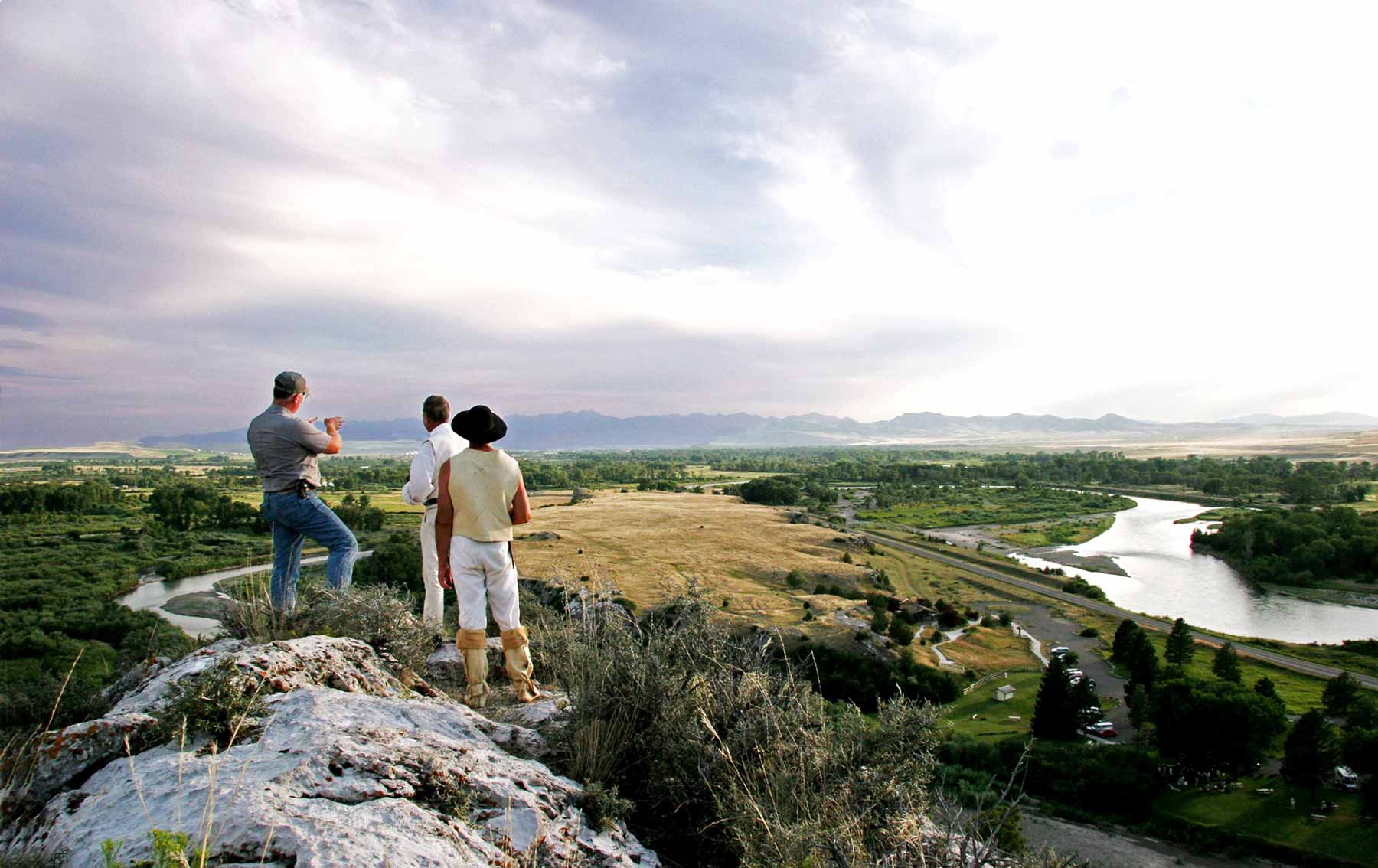
We’re on to the Top 5 Historic Sites In West Virginia. At #5 is one of the most famous scenic trails in American history. It’s the Lewis & Clark National Scenic Trail.
The Lewis and Clark National Scenic Trail is a trail that follows the route taken by the Lewis and Clark Expedition of 1804-1806.
The trail runs for about 4,900 miles, from Wood River, Illinois, to the Pacific Ocean in Oregon, passing through 11 states. The trail follows the Missouri River, the Columbia River and other waterways that were used by the explorers, and it also includes land routes used by the expedition.
The Lewis and Clark Expedition was led by Meriwether Lewis and William Clark, who were commissioned by President Thomas Jefferson to explore the western territory of the United States.
The expedition set out in 1804 with the goal of finding a water route to the Pacific Ocean, and they also sought to learn more about the plants, animals, and indigenous peoples of the region.
The Corps of Discovery returned to St. Louis in 1806, having accomplished many of their goals and making many important discoveries along the way.
It’s Not A Continuous Footpath
The Lewis and Clark National Scenic Trail was authorized by Congress in 1978, and since then the trail has been developed and maintained by the National Park Service. The trail is not a continuous footpath, but it is marked by signs and markers, and it includes a variety of trail segments, including hiking trails, bike trails, and water routes.
The Lewis and Clark National Scenic Trail offers a wide range of recreational opportunities for visitors, including hiking, biking, boating, and wildlife viewing.
The trail also provides visitors with an opportunity to learn about the history of the expedition, and to explore the diverse landscapes and cultures of the region. The trail has many trailheads, visitors center, and campgrounds along the route, making it easy to visit and enjoy different sections of the trail.
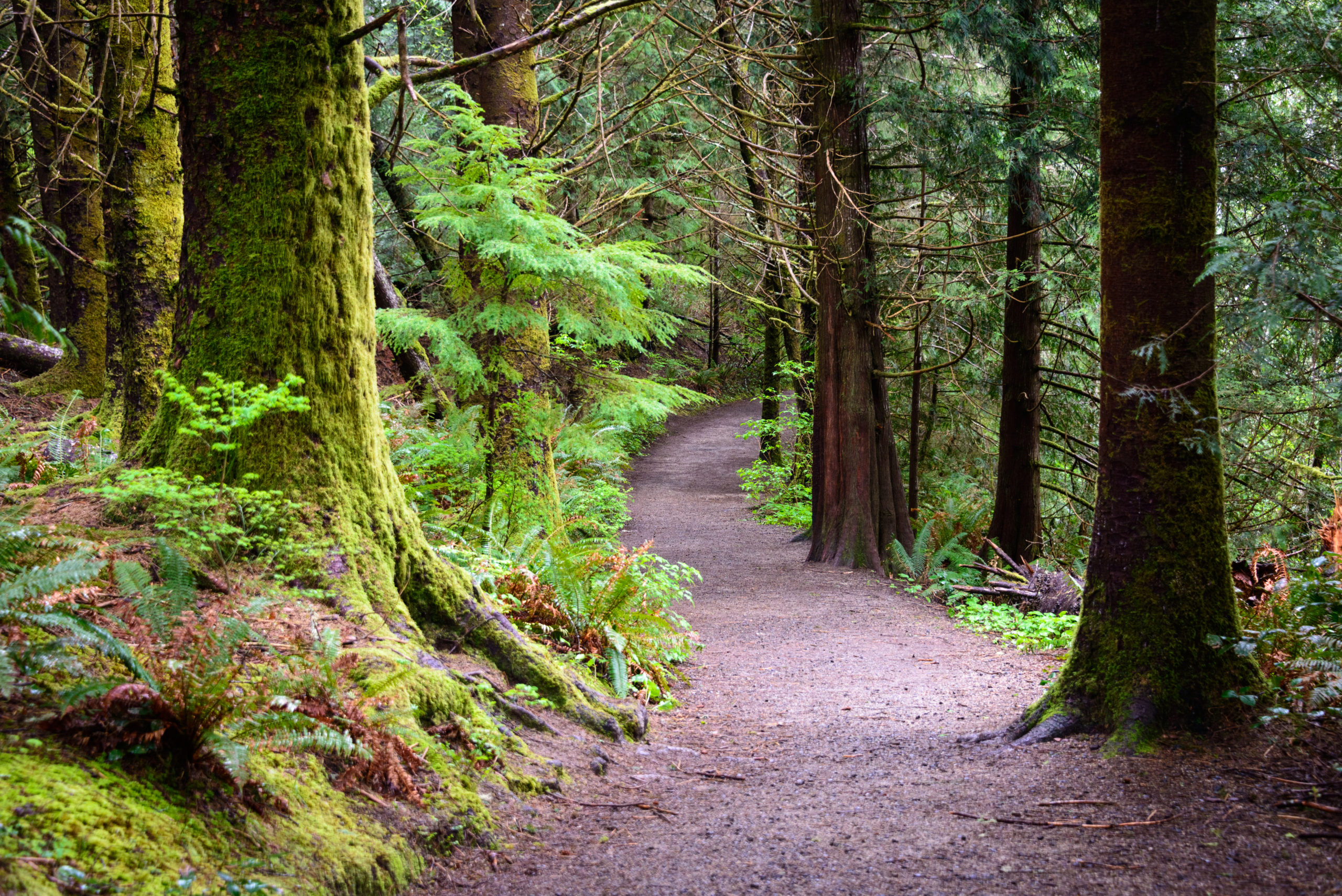
4. Appalachian National Scenic Trail
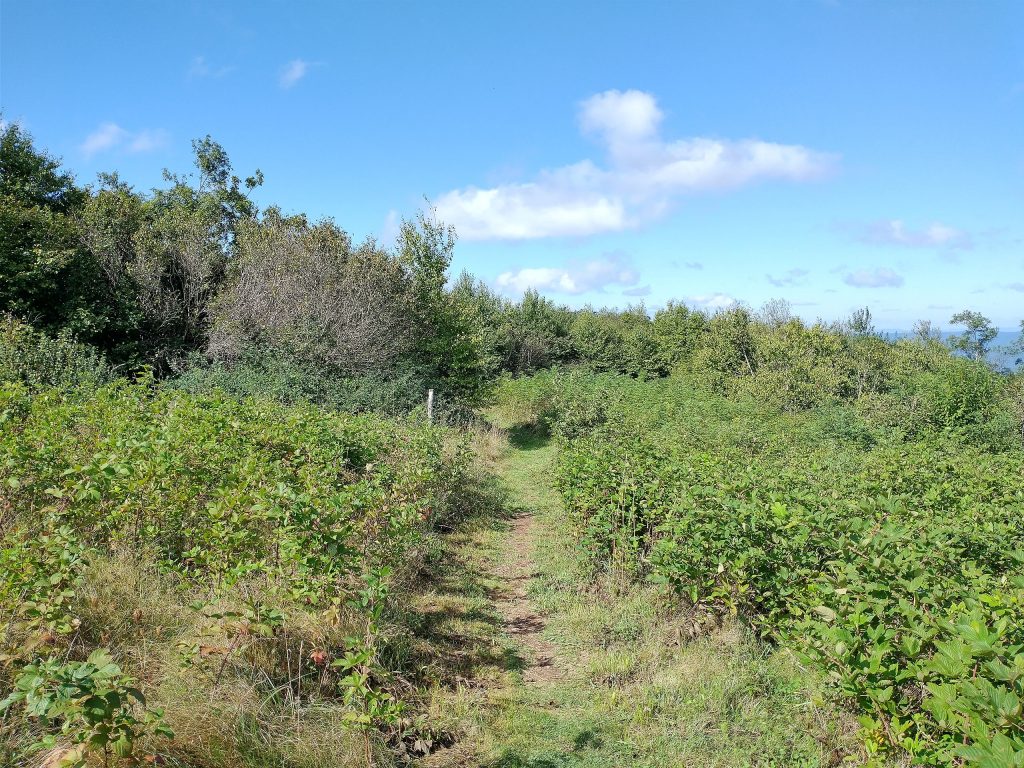
We’re on to the “Final Four.” At #4 is another famous historic trail – the Appalachian National Scenic Trail.
The Appalachian National Scenic Trail, commonly known as the “Appalachian Trail” or simply “the A.T.”, is a long-distance hiking trail that runs for about 2,190 miles (3,520 km) through the eastern United States.
It stretches from Springer Mountain in Georgia to Mount Katahdin in Maine. The trail passes through 14 states, including Georgia, North Carolina, Tennessee, Virginia, West Virginia, Maryland, Pennsylvania, New Jersey, New York, Connecticut, Massachusetts, Vermont, New Hampshire and Maine.
The idea for the trail was first proposed in 1921 by Benton MacKaye, a regional planner and forester. He envisioned a trail that would run the length of the Appalachian Mountains, providing a recreational and educational experience for the public. In 1925, the first section of the trail was opened in Bear Mountain State Park in New York.
Over the next several decades, the trail was constructed and maintained by a coalition of federal, state and local agencies, as well as volunteer groups, such as the Civilian Conservation Corps and the Appalachian Trail Conservancy.
The National Trails System Act
The trail officially opened in 1937, and in 1968 it was officially designated as the first National Scenic Trail by the National Trails System Act.
The trail is now considered one of the most iconic hiking trails in the world, and attracts thousands of hikers each year. It is known for its beautiful scenery, including views of the Appalachian Mountains, as well as its diverse plant and animal life.
The trail also passes through numerous small towns, providing hikers with the opportunity to experience the culture and history of the region.
The trail is considered to be one of the most challenging hikes in the world, it takes an average of 5 to 7 months to hike the entire trail and many hikers attempt to hike the trail in one season, known as a “thru-hike”.
Many hikers attempt to hike the trail each year, and only a small percentage of them are successful in completing the entire trail. If you decide to do it, may the force be with you.
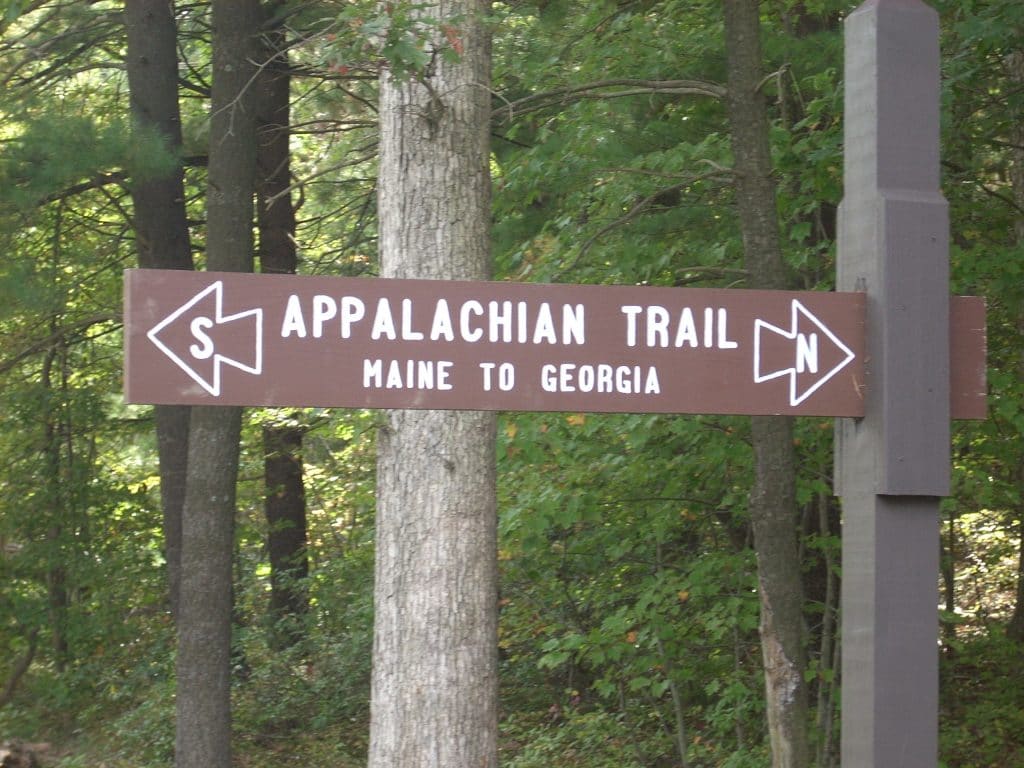
Check Out: 25 BUCKET-LIST Famous Landmarks In America (MUST-SEE)
3. Chesapeake & Ohio Canal National Historical Park
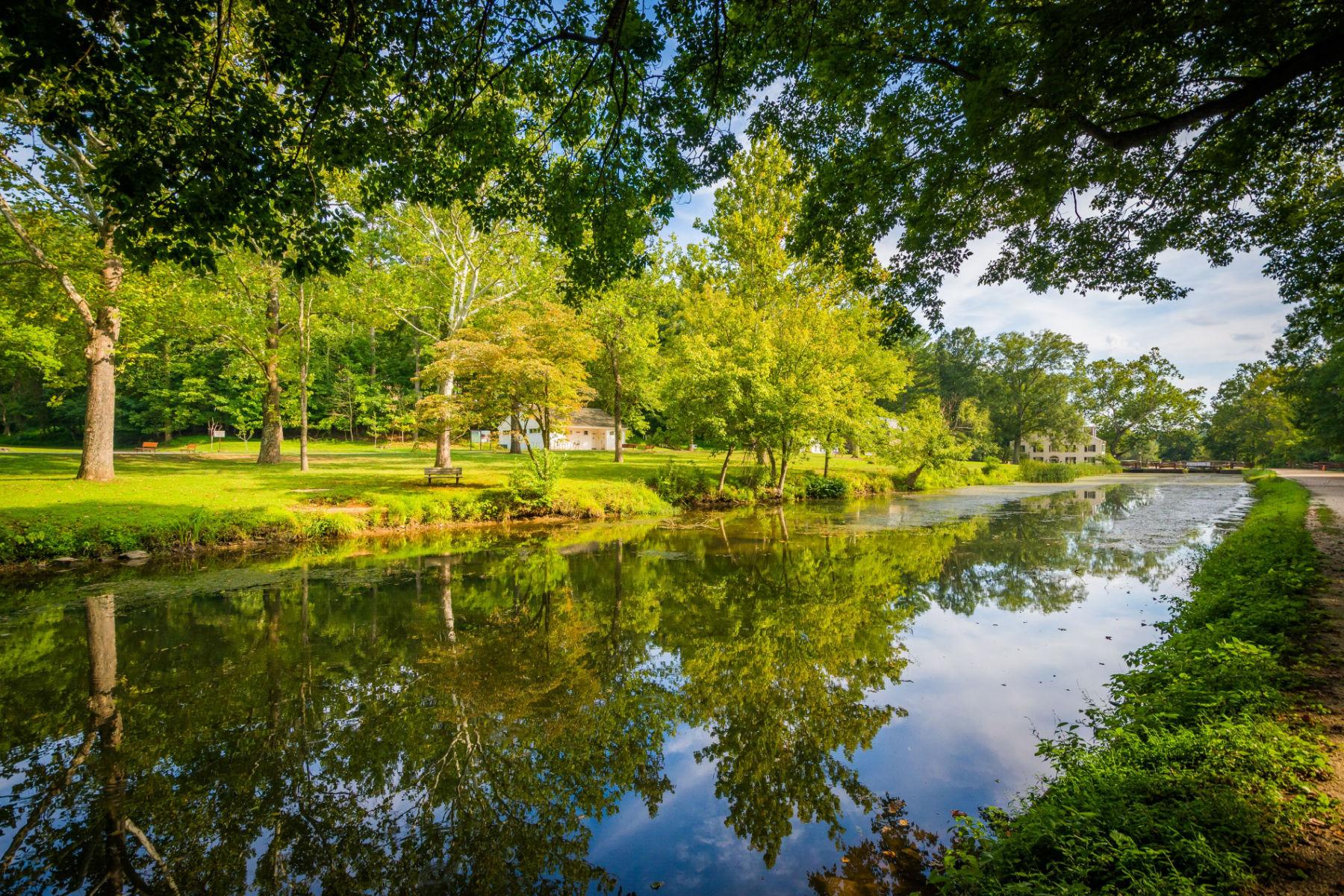
We’ve saved the best for last as we move on to our final three historic sites. At #3 is the Chesapeake & Ohio Canal National Historical Park.
The Chesapeake & Ohio Canal National Historical Park is located along the Potomac River in Maryland and in Washington D.C. The park preserves a section of the Chesapeake and Ohio (C&O) Canal, which was built in the early 19th century to connect the Potomac River with the Ohio River and the Midwest.
The C&O Canal was built between 1828 and 1850, and it was used to transport coal, lumber, and agricultural products. The canal was in operation for nearly 100 years, but with the advent of the railroad, the canal slowly fell into disuse and was officially closed in 1924.
The Chesapeake & Ohio Canal National Historical Park was established in 1971 to preserve the remaining sections of the canal, as well as the surrounding landscapes, historic structures, and cultural resources.
The park covers over 184 miles and includes more than 30 historic structures such as lockhouses, aqueducts, and canal-era buildings.
Things To Do
The park offers a variety of recreational opportunities, including hiking, biking, and boating on the canal. Visitors can also take a boat ride on the canal or hike along the towpath, which follows the route of the original canal.
The park also offers a variety of educational and interpretive programs, including ranger-led walks and talks, and living history demonstrations.
The Chesapeake & Ohio Canal National Historical Park is a popular destination for visitors, who come to explore the natural beauty of the area, learn about the history of the canal and the people who built and operated it, and experience the recreational opportunities offered by the park.
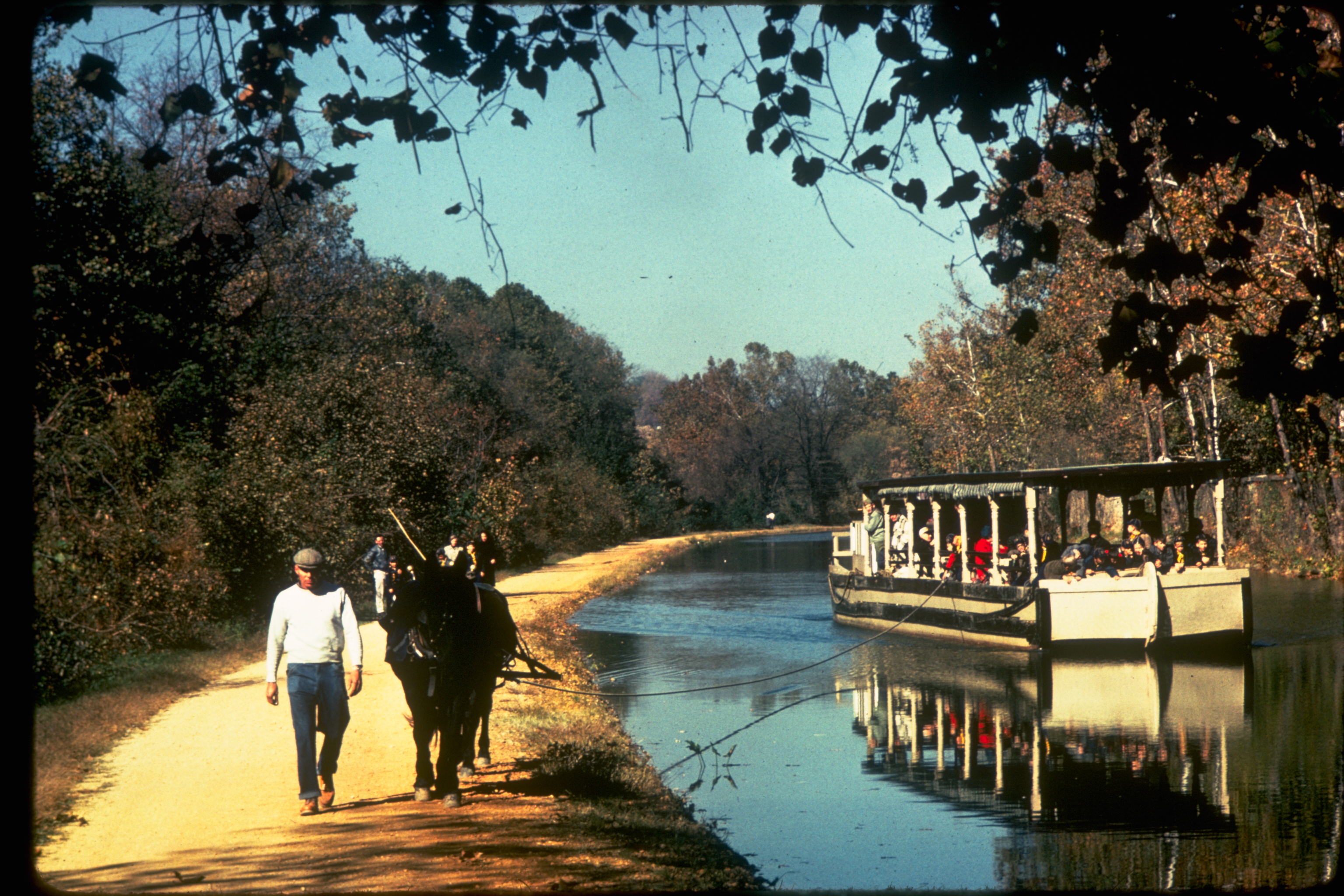
Check Out: 10 BEST Revolutionary War Sites In America
2. New River Gorge National Park & Preserve

Our runner-up in the #2 spot on our list of the Best Historic Sites In West Virginia is a magnificent national park. Just because we’re More Than Just Parks doesn’t mean that we’ve forgotten about them. At #2 is New River Gorge National Park & Preserve.
New River Gorge National Park and Preserve is a national park and preserve located in southern West Virginia.
The park encompasses over 73,000 acres of land and includes the New River Gorge, a 53-mile long river that is considered one of the oldest rivers in the world, as well as the surrounding landscapes, historic sites, and cultural resources.
The New River Gorge has a rich human history that dates back to the pre-colonial era, when various indigenous cultures lived in the region. The area was later explored by European settlers, and it was used for hunting, fishing, and farming.
In the 19th century, the area became an important center for the logging and coal mining industries.
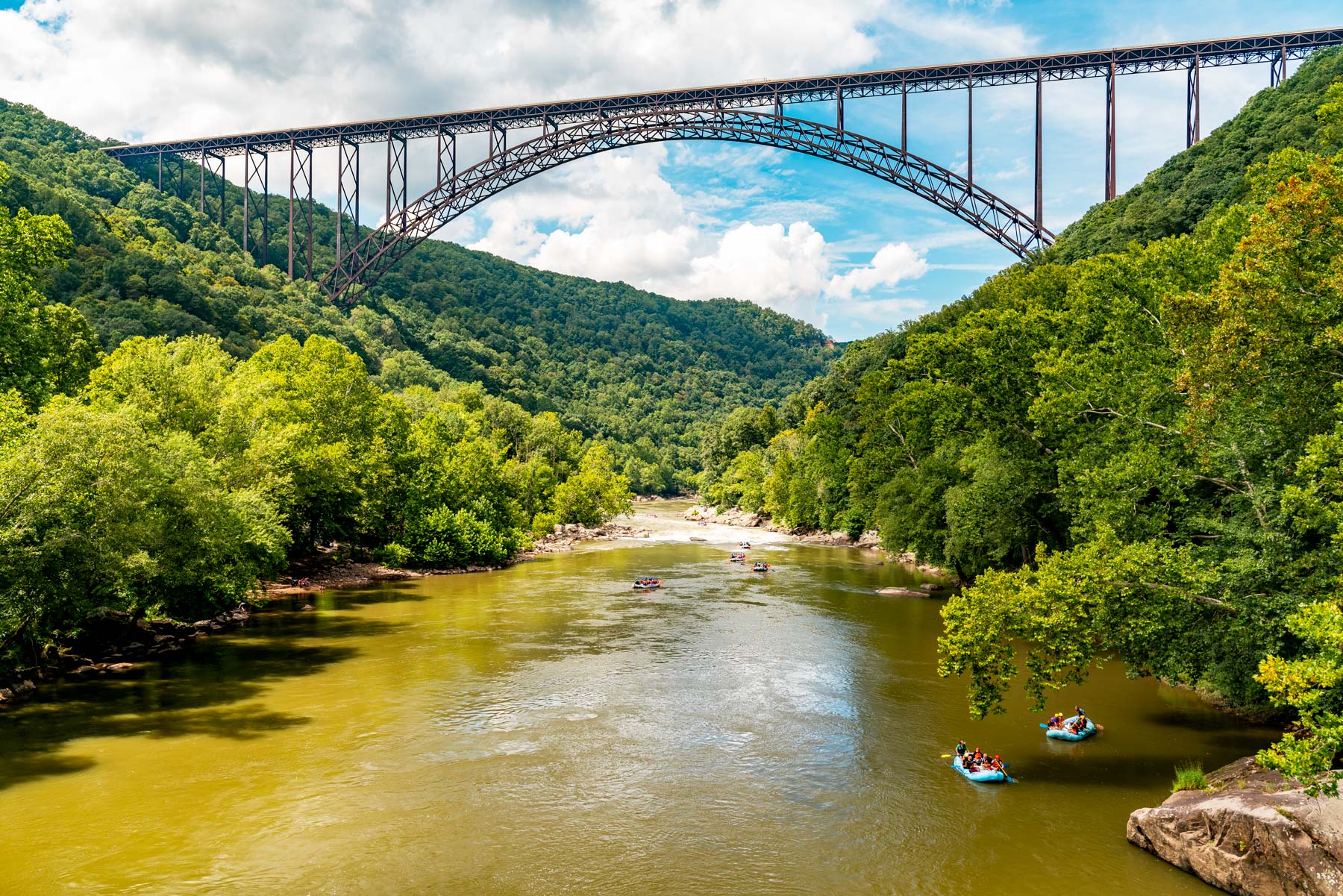
The New River Gorge Bridge, which spans the New River Gorge, was completed in 1977, and it was the longest steel arch bridge in the world at the time of its completion, making it an important engineering achievement.
The bridge also became a symbol of the region and an important landmark.
Things To Do At New River Gorge
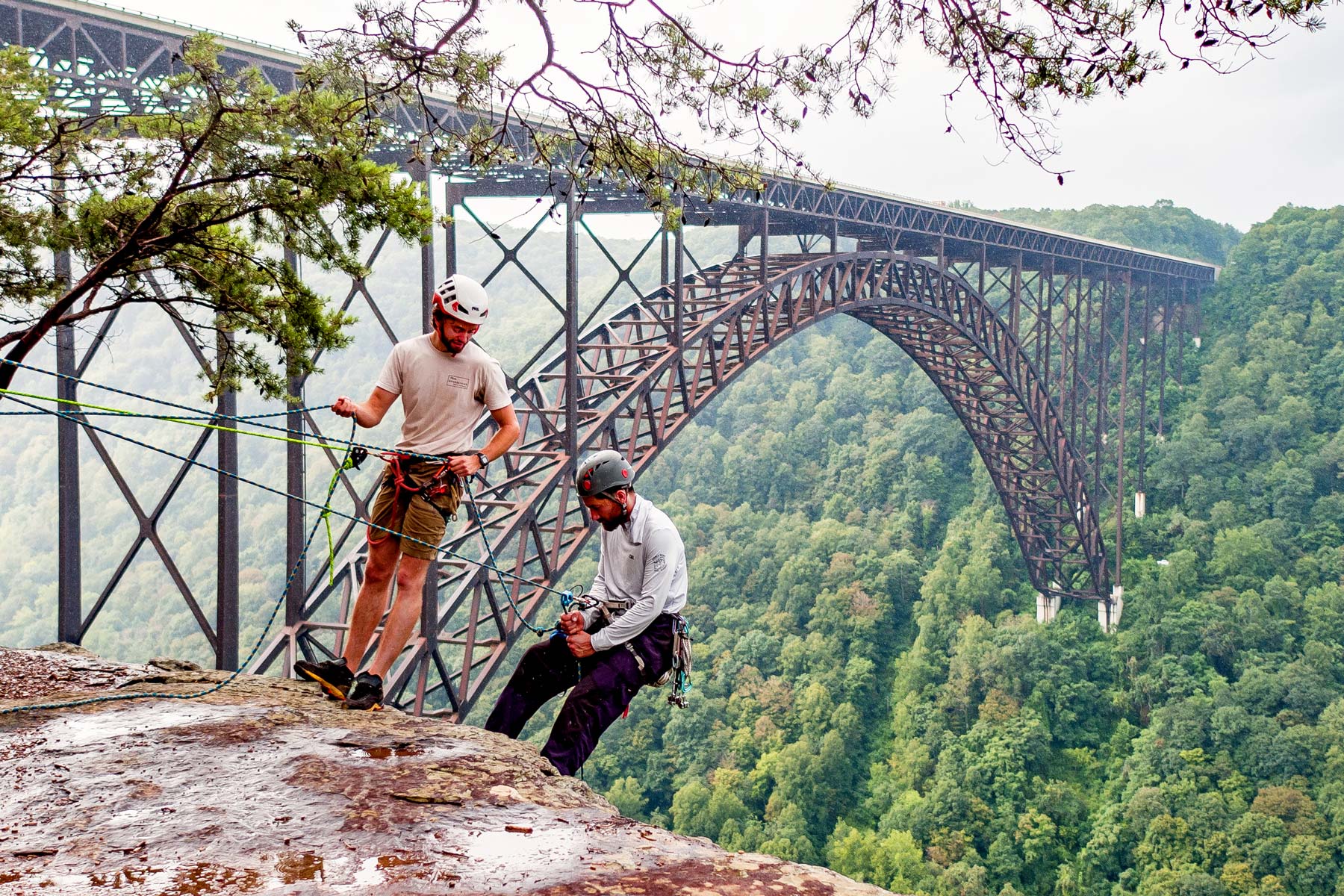
There are plenty of activities and things to do at New River Gorge National Park! Here are some suggestions:
- Hiking: The park offers over 100 miles of hiking trails that range from easy to strenuous. Some popular trails include Long Point Trail, Endless Wall Trail, and Kaymoor Miners Trail.
- Whitewater Rafting: The New River is known for its excellent whitewater rafting opportunities. There are several outfitters in the area that offer guided trips.
- Rock Climbing: The New River Gorge is one of the best rock climbing destinations in the eastern United States. There are over 1,400 established climbing routes in the park.
- Scenic Drives: The park has several scenic drives that offer beautiful views of the New River Gorge. The most popular is the Canyon Rim Drive, which runs for 14 miles along the rim of the gorge.
- Fishing: The New River is also a popular spot for fishing. The river is stocked with trout and smallmouth bass.
- Mountain Biking: The park offers several mountain biking trails, including the Arrowhead Trails and the Rend Trail.
- Camping: The park has several campgrounds that offer both primitive and RV camping. The most popular campground is the Canyon Rim Campground, which offers beautiful views of the gorge.
- Wildlife Viewing: The park is home to a variety of wildlife, including deer, black bear, and bald eagles. There are several areas in the park where you can view wildlife.
- Kayaking and Canoeing: In addition to whitewater rafting, the New River also offers opportunities for kayaking and canoeing. There are several sections of the river that are suitable for paddling.
- Photography: The park offers many opportunities for photography, including stunning views of the New River Gorge, wildlife, and wildflowers.

Check Out Our New River Gorge Film
Journey with More Than Just Parks as we explore a gorge teeming with rugged beauty, ancient waters, and epic overlooks. This is New River Gorge. Filmed primarily in stunning UHD 8K.
To create this film we spent a few weeks on location in New River Gorge National Park as part of a partnership with West Virginia Tourism. The purpose of the video is to highlight the park’s unique scenic, historic, and adventurous character as well as promote responsible recreation within.
1. Harpers Ferry National Historical Park

As the #1 Historic Site In West Virginia, we selected Harpers Ferry National Historical Park.
Just as the name of Francis Scott Key is inexorably connected to Fort McHenry so is the name of John Brown likewise linked with Harpers Ferry.
In October of 1859, Brown led a raid against the military arsenal at Harpers Ferry.
The raid was intended to be the first stage in an elaborate plan to establish an independent stronghold of freed slaves in the mountains of Maryland and Virginia.
Brown was captured during the raid. He was convicted of treason and hanged, but the raid served as a flashpoint.
In the North, Brown was hailed as a hero while is the South he was depicted as the devil incarnate. This event helped move the two sections of America ever closer to Civil War.
CHECK OUT: 27 EPIC Maryland National Parks Worth Visiting
Things To Do At Harpers Ferry
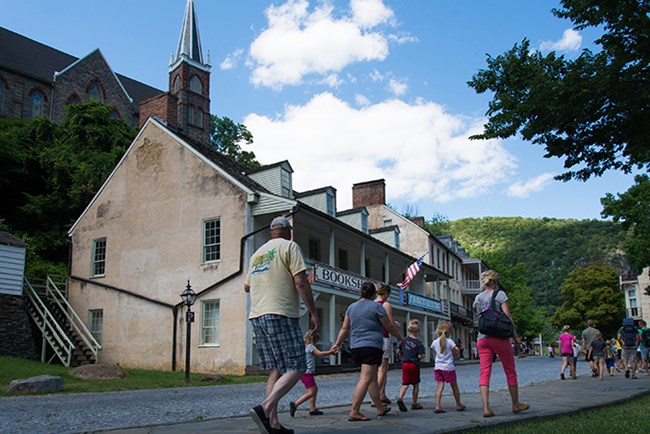
- Hiking: The park offers several hiking trails, including the Appalachian Trail, the Maryland Heights Trail, and the Loudoun Heights Trail. These trails offer scenic views of the surrounding landscape.
- History Tours: Harpers Ferry played a significant role in American history, and there are several guided tours available to learn more about the town’s history.
- River Activities: Harpers Ferry is located at the confluence of the Potomac and Shenandoah Rivers, offering opportunities for kayaking, tubing, and fishing.
- Civil War History: The town of Harpers Ferry was the site of a significant Civil War battle, and there are several sites within the park that commemorate this history, including Bolivar Heights and the Murphy Farm.
- Biking: The C&O Canal Towpath and the Chesapeake Bay Gateways Network offer several biking trails that run through Harpers Ferry.
- Photography: The park’s historic buildings, scenic views, and natural beauty make it an excellent location for photography.
- Living History Programs: The park offers living history programs that recreate life in the 19th century, including blacksmithing, cooking, and traditional crafts.
- Bird Watching: The park is home to several bird species, including bald eagles, ospreys, and blue herons.
- Ghost Tours: Harpers Ferry is rumored to be one of the most haunted towns in America, and there are several ghost tours available to explore the town’s supernatural history.
- Appalachian Trail Museum: The park is home to the Appalachian Trail Conservancy’s museum, which showcases the history and culture of the Appalachian Trail.
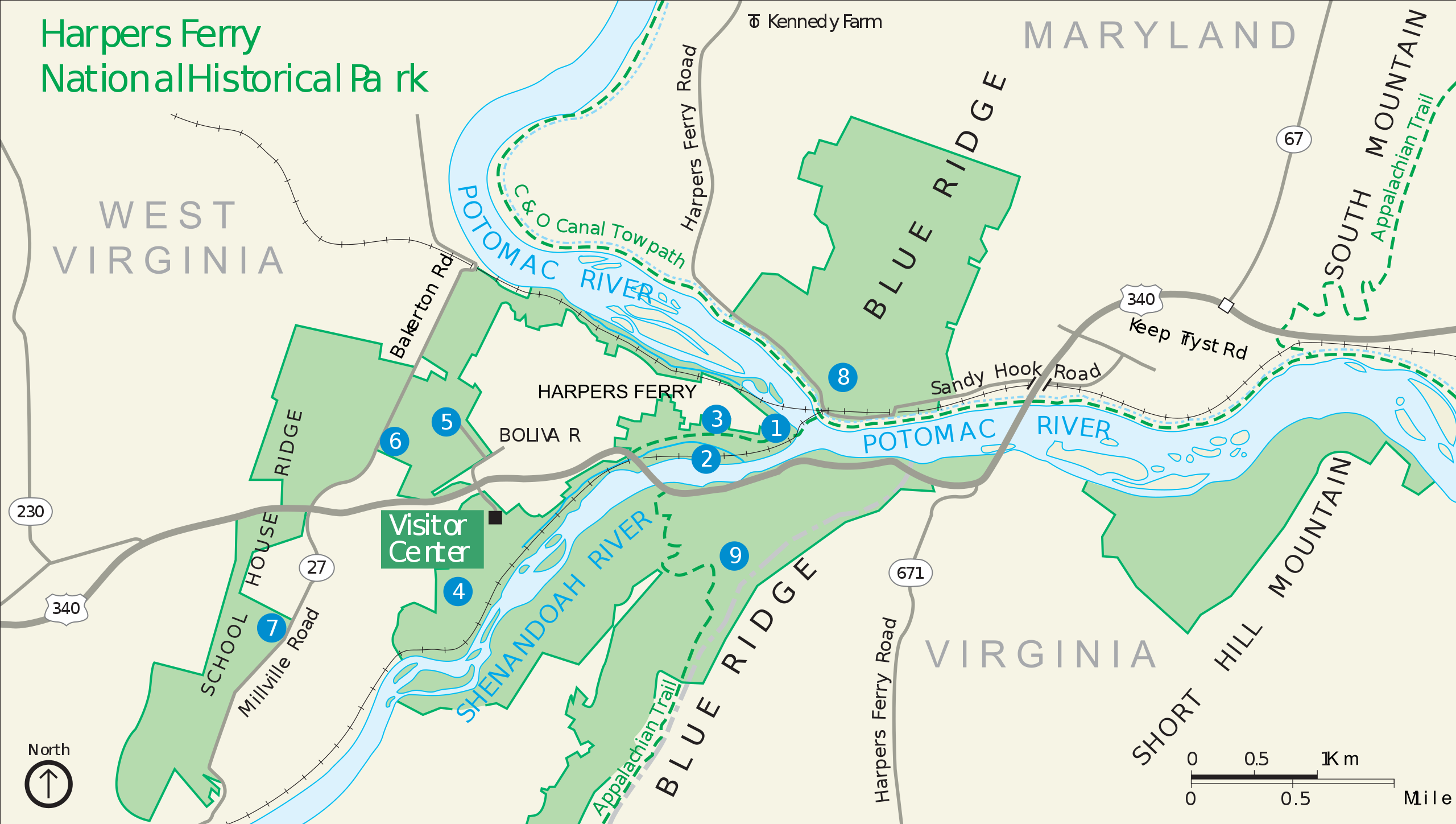
Check out: 30 EPIC Virginia National Parks Worth Visiting
List Of Historic Sites In West Virginia
- Harpers Ferry National Historical Park
- New River Gorge National Park & Preserve
- Chesapeake & Ohio Canal National Historical Park
- Appalachian National Scenic Trail
- Lewis & Clark National Historic Trail
- The Greenbrier
- West Virginia State Museum
- Matewan Historic District
- Grave Creek Mound Historical Site
- Cass Scenic Railroad State Park
Why Trust Us About Historic Sites In West Virginia?
We’re Jim Pattiz and Will Pattiz, collectively known as the Pattiz Brothers and we absolutely LOVE the national parks.
You should probably know that we don’t just make this stuff up out of thin air. We’ve spent our entire adult lives exploring and filming America’s national parks and public lands.
We’ve worked with the National Park Service, the Department of Interior, USDA, U.S. Forest Service, and more for years creating films on important places and issues. Our work has been featured in leading publications all over the world and even some people outside of our immediate family call us experts on the national parks.
And, in 2018, our father – having spent a lifetime teaching history – joined us so that he could help us to tell the stories behind these amazing places.
Meet The Parks Brothers
We Hope You’ll Follow Our Journey

Our goal here at More Than Just Parks is to share the beauty of America’s national parks and public lands through stunning short films in an effort to get Americans and the world to see the true value in land conservation.
We hope you’ll follow our journey through the parks and help us to keep them the incredible places that they are. If you’re interested joining the adventure, sign up below!

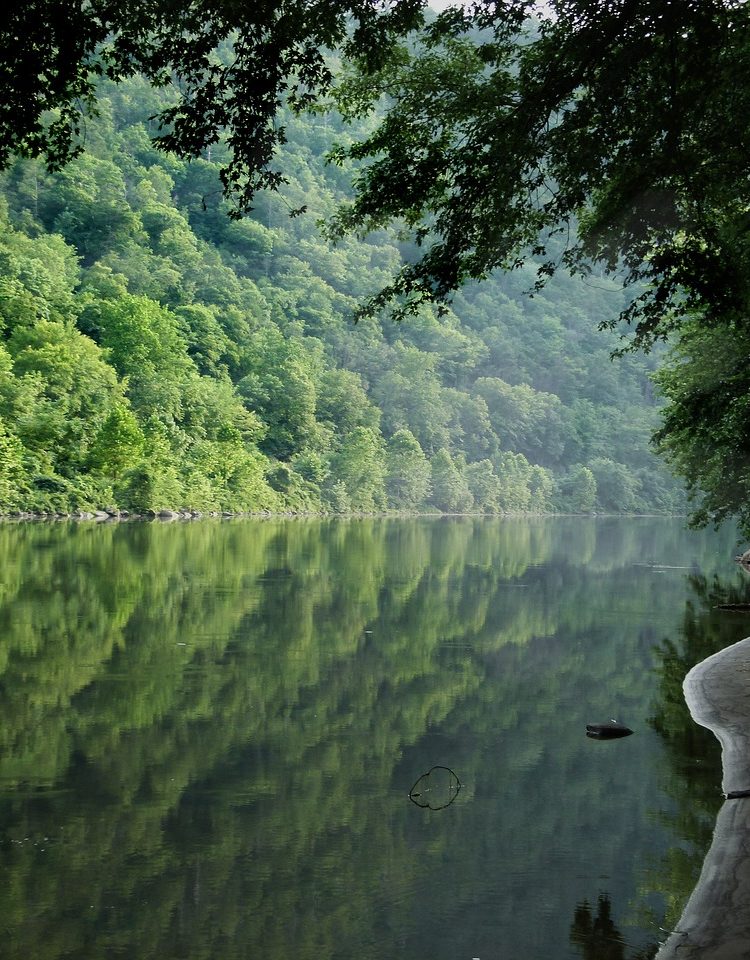



Leave a Reply